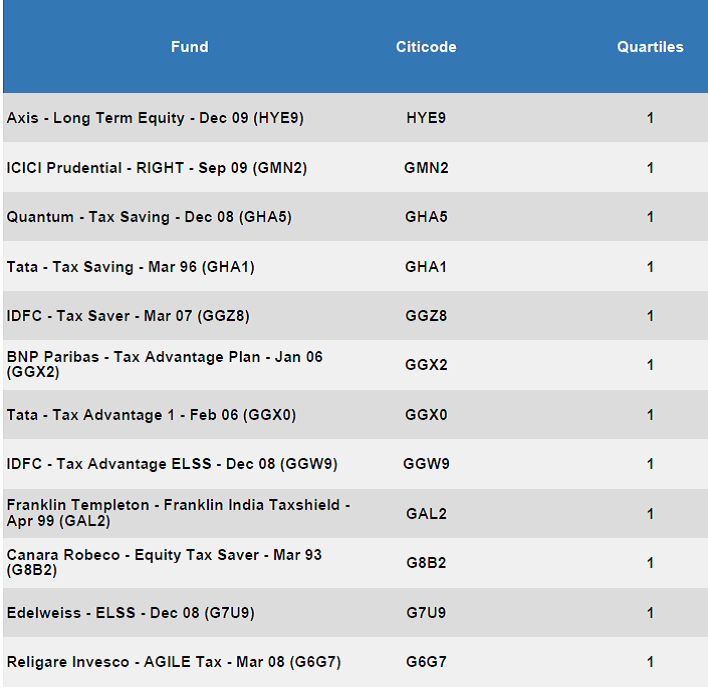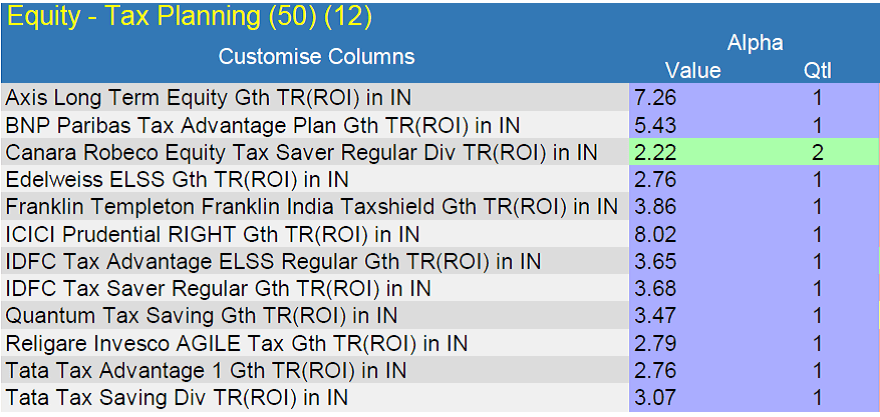Tax saving season has started off. Many mails are pouring into my Mailbox asking for best tax saving mutual funds to invest in. As I always say that there’s nothing that can be called as best, but there should be a process of selecting any investment and your selection should match your risk profile. In this particular case, we are talking of tax saving mutual funds also known as ELSS (Equity Linked saving Scheme) which are pure equity funds, so one has to be alive with the volatility. This article highlights the tax saving mutual funds which satisfies the criteria and process which I follow and advise to follow. You may go through my Money control article – 5 parameters of selecting mutual funds to understand it better.
Like for all equity funds, in tax saving mutual funds we’ll follow the same criteria.First parameter to select good tax saving mutual fund is to check out its performance ranking. Now here in this case I am not taking about top performer or best returns, but a good decent return and presence among top 25% of tax saving mutual funds scheme. To check out the consistency, we’ll apply this parameter to 3 years time frame. Below is the list of tax saving mutual funds which results out of this criteria.
Source: FE analytics, Date : 17 Oct’2013. Rank= Quartile 1 in 3 years.
Please note that some of the funds mentioned above may not be open to invest as they are close ended funds.
Second parameter says that the fund manager should be generating ALPHA. Alpha tells what extra or less the fund manager has generated in comparison to benchmark. This actually is the performance ranking of fund manager. If we are paying fees for active management, our fund has to be actively managed and should generate return more than market. On applying this criteria on the above list of tax saving Mutual funds we found the following list, which is carrying the same funds as mentioned above. Means that all of the funds which are in quartile 1 in last 3 years has generated alpha more than 1.
Source: FE analytics, Date: 17 Oct’2013. Alpha >=1 over 3 years performance.
Third parameter is to check the expenses we are paying to AMC in the shape of total expense ratio. This expense ratio is the factor of Assets under Management of particular fund. Bigger the fund size, lesser would be the expenses. Though there is a scope of charging upto 3% of average daily net assets in equity mutual funds but still lesser the better. In the above filter I added a parameter of expense ratio <=2.5% and below are the results. Only 2 funds out of the above 12 qualify this criteria.
Source: FE analytics, Date: 17 Oct’2013.
This particular parameter is avoided many times when investor feels that if a fund house is generating good returns it is fine if they are charging high. So this parameter is left open for everyone to decide. But if the performance of 2 funds is comparable then expense ratio plays a very important part.
Next parameter in selecting tax saving mutual fund is to find out the tenure of Fund manager managing this fund. As we are taking all parameters in 3 years , so the fund manager should also be having tenure of atleast 3 years managing this fund. Applying this criteria in selecting tax saving mutual funds we’ll get the results as below.
Source: FE analytics, Date: 17 Oct’2013.
Last parameter to zero on to tax saving mutual funds to invest in, is to find out the Total assets which that particular fund is managing. The idea of having a decent AUM is to reduce the risk of concentration of AUM among few investors. Also higher the AUM will lead to less expense ratio. Now as far as expense ratio point of view both the above mentioned funds are fine, but if we put the condition of having AUM of Rs 200 crore and above then we get only one fund.Read more :Mutual fund Case study
FRANKLIN TEMPLETON – Franklin India Tax shield
Source: FE analytics, Date: 17 Oct’2013.
So this time we have a clear winner fund after the filtering of various Tax saving mutual funds. Generally this doesn’t happen, and at this point we are left with some 5-6 funds which we have to further filter them with quarterly rankings, alpha, standard deviations, sharpe ratio, manager managing other funds etc. but it is not required this time. (Read : understanding how to measure mutual funds risk)
Many advisors have different ways of selecting funds, but i follow this process of filtering. But do note that this is result as on today and as they say that mutual funds are subject to market risk and move along with market movements, so the result may or may not get changed tomorrow. And this happens with every mutual fund. After investing in tax saving mutual funds we cannot do anything before 3 years, but for other open ended mutual funds we need to keep on reviewing the parameters every 2nd quarter. (Read more:Make your investment tax efficient case study)
Check out our Mutual funds review service.
What are your views? Did you find this Article on Tax saving Mutual funds helpful?












 Manikaran Singal is the founder and Chief financial planner at Good Moneying Financial Solutions. He is a CERTIFIED FINANCIAL PLANNER CM and SEBI registered Investment adviser (Regd no. INA 100001620). He’s having 20+ years of experience in financial services space.
Manikaran Singal is the founder and Chief financial planner at Good Moneying Financial Solutions. He is a CERTIFIED FINANCIAL PLANNER CM and SEBI registered Investment adviser (Regd no. INA 100001620). He’s having 20+ years of experience in financial services space.

